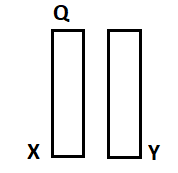Question
Question: Two conducting plates \({{X}}\) and \({{Y}}\) , each having large surface area \({{A}}\) (on one sid...
Two conducting plates X and Y , each having large surface area A (on one side), are placed parallel to each other as shown in figure. The plate X is given a charge Q whereas the other is neutral. Find:

(a) the surface charge density at inner surface of the plate X
(b) the electric field at a point to the left of the plates
(c) the electric field at a point in between the plates and
(d) the electric field at a point to the right of the plates
Solution
For plate X, the net charge given to the plate will be equally distributed on both the sides and the charge developed on the each side will be q1=q2=2Q. Charge density on the left side and the right side of the plate is σ=2AQ. Use these relations to find out the electric field at a point to the left, right and in between the plates.
Complete step by step solution:
Given: The surface area of conducting plates X and Y is A
Plate X is charged while plate Y is uncharged.
(a) Finding the surface charge density at inner surface of the plate X
Let us consider that the surface charge densities on both sides of the plate be σ1andσ2.
Electric field due to plate is given by
E=2ε0σ
Thus, the magnitudes of electric fields due to plate on each side is given by
⇒2ε0σ1 and 2ε0σ2
The plate has two sides and the area of both the sides is A.
Hence, the net charge given to the plate will be equally distributed on both the sides.
The charge developed on the each side will be q1=q2=2Q
Therefore, the net surface charge density on each side will be 2AQ.
(b) Finding the electric field at a point to the left of the plates
Charge density on the left side of the plate is given by
σ=2AQ
Hence, the electric field is 2Aε0Q
(c) Finding the electric field at a point in between the plates
The charge developed on the each side of the plate is q1=q2=2Q
Electric field due to plate is given by
⇒E=ε0σ
⇒E=ε0σ=ε0(Q/2)/A
On further solving, we get
⇒E=2Aε0Q
Thus, the electric field at a point in between the plates is 2Aε0Q.
(d) Finding the electric field at a point to the right of the plates
Charge density on the left side of the plate is given by
σ=2AQ
Hence, the electric field is 2Aε0Q
Note: Electric field is defined as the electric force per unit charge. The plate X is positively charged and plate Y is neutral. Here, the charged plate acts as a source of electric field with positive in the inner side and a negative charge is induced on the inner side of plate Y.
